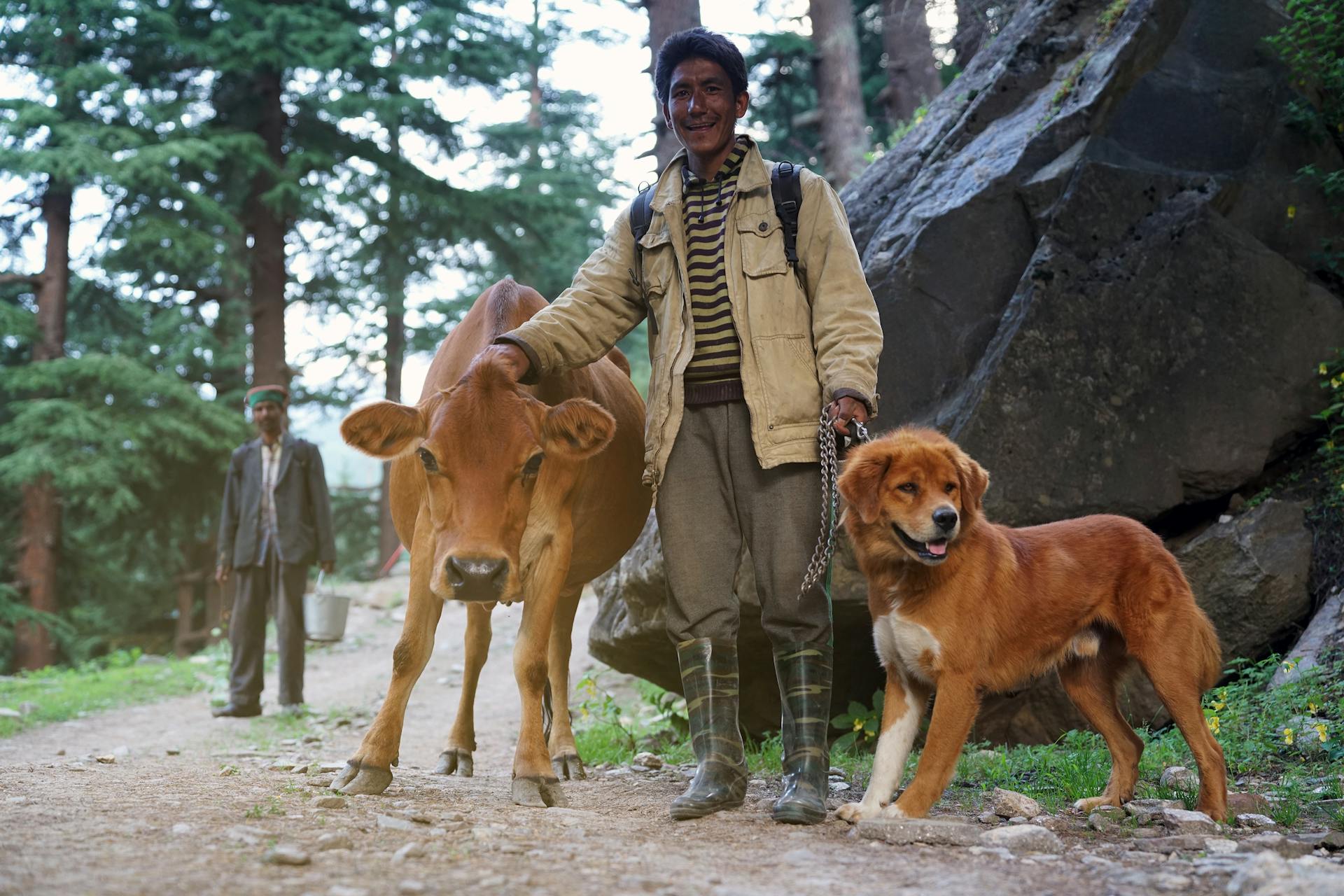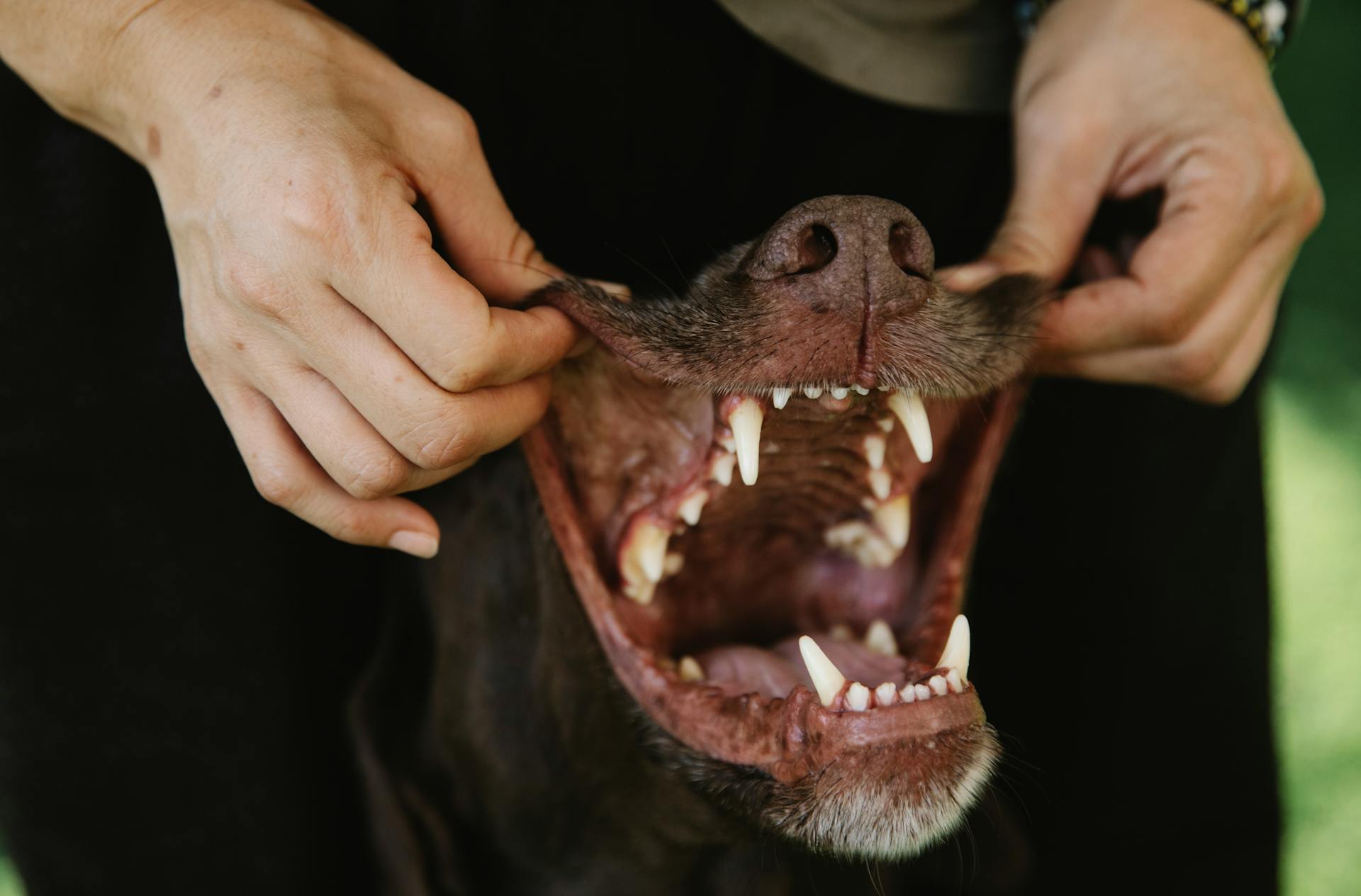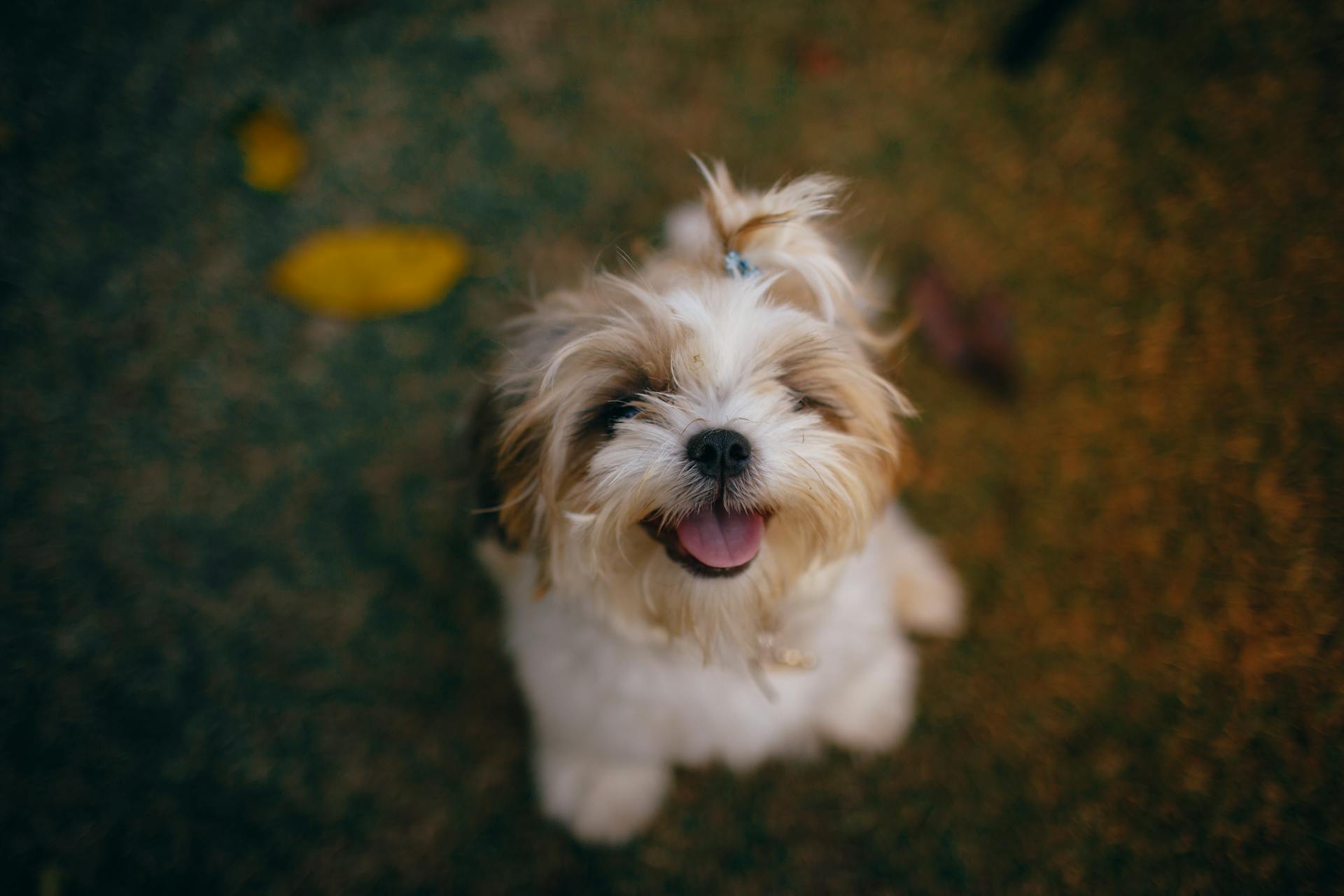
The Wetterhoun is a unique breed with a rich history. They originated in the Netherlands, specifically in the province of Frisia, where they were bred to hunt waterfowl.
Their name "Wetterhoun" translates to "water dog" in English. This name is a testament to their original purpose.
Wetterhouns are medium-sized dogs with a muscular build. They typically weigh between 55 and 75 pounds.
Their distinctive appearance includes a curly, wiry coat that requires regular grooming.
The Distinct Look
The Wetterhoun's curly coat is a sight to behold, and it's not just for show - it's a natural defense against the elements. This dual-layered coat is oily to the touch, providing both protection and warmth.
Their coat can come in a variety of colors, including solid black, solid brown, or black and white, with or without ticking or roaning. They can also have brown and white coats.
One of the most distinctive features of the Wetterhoun is their tail, which curls tightly over the back. This is a unique feature that sets them apart from other breeds.
Their feet are also quite remarkable, with webbing that enhances their swimming abilities. This adaptation allows them to navigate the wetlands of their homeland with ease.
The Wetterhoun's eyes are oval-shaped and slant slightly, giving them a serious, almost grim expression. This, combined with their broad heads and well-developed noses, makes for a unique and striking appearance.
Origins and History: From Frisian Fields to Family Homes
The Wetterhoun breed has its roots in the Dutch province of Friesland, where it originated over 400 years ago.
The breed's name, "Wetterhoun", literally translates to "water dog" in Dutch, which makes sense given its history as a water retriever and hunter.
The Wetterhoun is believed to have descended from the now-extinct Old Water Dog, and possibly an indigenous Frisian breed.
The Wetterhoun's original purpose was to hunt fitch, otter, and other small animals, as well as retrieve waterfowl.
Thanks to careful breeding efforts, the breed was saved from near-extinction during World War II.
Today, the Wetterhoun is recognized by the Federation Cynologique International and the United Kennel Club, but not by the American Kennel Club.
Despite its rarity, the Wetterhoun is a treasured part of the Netherlands' canine heritage and is increasingly finding its place in homes beyond its native land.
A fresh viewpoint: American Kennel Club Lancashire Heeler
Temperament and Personality

The Wetterhoun is a breed that's often described as strong-willed and reserved, but don't let that fool you - they're also incredibly loyal and loving to their families.
They have a natural guarding ability, making them watchful around strangers, but they're not aggressive by nature. This makes them a great fit for family environments where they can develop strong bonds with their human pack.
Their intelligence requires training methods that are firm, consistent, but never harsh. They can be stubborn at times, but with the right approach, they'll learn to listen and obey.
Socialization from an early age is key for Wetterhouns, helping them get along well with other pets and children in the family. However, their high prey drive may make them a bit challenging to socialize with cats and small animals.
Here are some key temperament traits to keep in mind when considering a Wetterhoun as a pet:
Overall, the Wetterhoun is a breed that requires patience, consistency, and positive reinforcement training. But with the right approach, they'll reward you with a lifetime of love, loyalty, and companionship.
Care and Maintenance
Wetterhouns are relatively low-maintenance pets, but they do require some regular care and attention.
To keep your Wetterhoun happy and healthy, provide ample exercise and mental stimulation. This can be as simple as a daily walk or playtime in the yard.
A balanced diet is also essential for your Wetterhoun's overall health and contentment. Regular vet check-ups will help ensure any potential health issues are caught early.
Their coat is naturally oily and water-resistant, but it still needs some regular care. Brush their coat once or twice a week to keep their fur looking its best.
Here's a quick rundown of the essential grooming needs for your Wetterhoun:
- Brush their coat once or twice a week
- Check their ears regularly to ensure they're clean, dry, and free of infection
- Brush their teeth a few times a week to prevent tartar buildup and promote good oral health
Remember, occasional baths are sufficient to maintain the healthy state of their coat.
Health and Nutrition
The Wetterhoun is a hardy breed, but like all breeds, they have their share of health concerns. They're prone to joint issues such as hip dysplasia and patellar luxation, which can affect their mobility.
A balanced diet is crucial to mitigate the risk of inherited conditions like Severe Combined Immunodeficiency Syndrome. With proper care and regular vet check-ups, the Wetterhoun can lead a healthy life.
Their average lifespan is 12 to 13 years, reflecting their overall robust nature. Regular monitoring for signs of joint issues and other health problems can go a long way in ensuring your Wetterhoun remains in good health.
To diagnose joint issues, your veterinarian may perform a combination of the following tests:
- Canine Hip Dysplasia (CHD) diagnosis
- Blood and urine analysis
- X-rays or other radiographic imaging
- Skin and hair exams
Health Considerations
The Wetterhoun is generally a hardy breed, but like all breeds, they have their share of health concerns. Joint issues like hip dysplasia and patellar luxation can affect their mobility.
Hip dysplasia is a common problem in Wetterhouns, and it's essential to monitor for signs of this condition. Regular vet check-ups can help detect any issues early on.
Patellar luxation is another joint issue that can affect Wetterhouns. It's a condition where the kneecap slips out of place, causing pain and discomfort.
Suggestion: Hip Dysplasia Bernese Mountain Dog
Severe Combined Immunodeficiency Syndrome (SCID) is a rare genetic disorder that can lead to death in certain breeds. It's crucial to work with a reputable breeder who prioritizes genetic diversity.
To ensure your Wetterhoun stays healthy, regular monitoring for signs of joint issues and other health problems is essential. A balanced diet and proper care can also go a long way in keeping them in good health.
Here are some common health problems associated with Wetterhouns:
- Hip dysplasia
- Patellar luxation
- Severe Combined Immunodeficiency Syndrome (SCID)
Diet and Nutrition
The Wetterhoun's diet and nutrition needs are pretty straightforward. They can thrive on high-quality dog food, whether it's commercially prepared or cooked at home with your vet's approval.
A Wetterhoun's high energy level means they need a dog food formulated for active breeds to meet their nutritional needs.
Their hunting breed background means they're naturally inclined to be active and need food that can keep up with their energy levels.
To ensure your Wetterhoun gets the right nutrients, consider a dog food that's designed for active breeds.
Curious to learn more? Check out: How Much Exercise Do Labrador Retrievers Need
Training and Socialization
Training a Wetterhoun can be a challenge due to their independent nature, requiring patience and consistency from their owners.
Start their training as early as possible, ideally from a young age, to help them become well-behaved and responsive dogs.
Their strong-willed temperament means that structured and consistent training is key, focusing on one activity at a time to respect their persistent nature.
Positive reinforcement is the way to go, as Wetterhoun dogs can be sensitive and respond better to rewards and praise rather than punishment.
Socialization is just as important as training, providing a solid foundation for a well-rounded and sociable dog.
Exposure to different people, animals, and environments from an early age can help prevent fear and anxiety in Wetterhoun puppies.
Puppy classes are a great way to start socialization, helping to ensure your Wetterhoun grows into a confident and friendly companion.
Expand your knowledge: Breeds of Dogs That Start with H
Finding and Choosing a Wetterhoun
Finding a Wetterhoun can be a challenging task due to their rarity. The breed is primarily found in the Netherlands, with those outside the region usually imported from Europe.
If you're set on bringing a Wetterhoun into your home, your best bet would be to work with reputable breeders located in the Netherlands. Engaging with specific breed clubs and registries dedicated to this rare breed may also be necessary.
Given their size and exercise needs, Wetterhouns are not recommended for apartment living and prefer a home with a yard where they can roam and play freely.
A different take: German Shorthaired Pointer Free to Good Home
Finding a Breed
Finding a Wetterhoun can be a challenging task due to the breed's rarity.
The Wetterhoun is primarily found in the Netherlands, so you may need to look outside of your local area to find one.
There are no Wetterhoun rescue organizations, so adopting from a shelter is unlikely.
You may need to engage with specific breed clubs and registries dedicated to the Wetterhoun, such as those recognized by the Federation Cynologique International and the United Kennel Club.
Reputable breeders in the Netherlands are your best bet for finding a Wetterhoun, but be prepared for a search that may take some time.
Finding a Wetterhoun may require some persistence, but the joy and companionship they bring to a household makes the effort worthwhile.
Recommended read: Why Are Labrador Retrievers so Popular
Choosing the Right Breed
If you're considering bringing a Wetterhoun into your family, it's essential to think about your living situation. A Wetterhoun is not recommended for apartment living due to their size and exercise needs.
They prefer a home with a yard where they can roam and play freely. This breed needs space to move around and get some exercise.
Wetterhouns may prefer to be the only pet in the household, so it's best to have them as the solo furry friend. They're not typically recommended for homes with other dogs.
With children, Wetterhouns can form close bonds, but it's crucial to ensure proper socialization and respectful behavior from the little ones.
Similarly Sized Breeds
If you're looking for breeds that are similar in size to the Wetterhoun, you've got a few options to consider.
The Chien d'Artois is a great match, with a similarity rating of 98%. They're a medium-sized breed that's relatively easy to care for.

The Boxmatian and Spanierd are also good matches, with similarity ratings of 96%. These breeds are also medium-sized, but they have slightly different temperaments and grooming needs.
If you're interested in a breed with a strong herding instinct, the Dutch Shepherd is a good choice. They have a similarity rating of 96% and are known for their intelligence and energy.
The Dalmador is another breed that's worth considering, with a similarity rating of 96%. They're a medium-sized breed that's friendly and outgoing.
Frisian Water Dog Guide
The Frisian Water Dog, also known as the Wetterhoun, is a rare breed with a rich history.
The Wetterhoun originated in the Netherlands, specifically in the northern region of Friesland, over four centuries ago. Its development as a landrace breed means it was created without a formal registry, adapting to its environment.
This breed is primarily found in the Netherlands, with those outside the region usually imported from Europe. If you're looking to bring a Wetterhoun into your home, your best bet would be through reputable breeders located in the Netherlands.
The Wetterhoun's curly coat and webbed feet are a nod to its history as a versatile hunting dog. Its keen intelligence and protective nature make it a loving family member and diligent guardian.
Due to the breed's rarity, potential owners may need to engage with specific breed clubs and registries dedicated to this rare breed. The Federation Cynologique International and the United Kennel Club recognize the Wetterhoun, but it is not recognized by the American Kennel Club.
The Wetterhoun's history is marked by challenges, including its near extinction during World War II. However, thanks to the dedication of breed enthusiasts, careful breeding efforts post-war led to the breed's survival and resurgence.
The Wetterhoun's original function was as a hunter of otter, a predator deemed a threat to the area's fishing industry. It also proved adept at hunting other small animals and locating and retrieving game birds, both in and out of the water.
On a similar theme: Roman War Dog Cane Corso
Frequently Asked Questions
What breeds are in a Wetterhoun?
A Wetterhoun is a cross between Romani dogs and an indigenous Frisian dog, specifically the now extinct Old Water Dog. This unique ancestry contributes to the breed's distinctive characteristics.
How big are Wetterhoun dogs?
Wetterhoun dogs are medium-sized, typically measuring 21.6-23 inches tall and weighing 55-77 pounds at maturity. They are a sturdy breed with a compact build.
Featured Images: pexels.com

